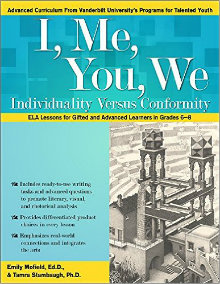ELA Lessons Explore Individuality & Conformity
I, Me, You, We: Individuality Versus Conformity: Common Core ELA Lessons for Gifted and Advanced Learners in Grades 6-8
By Emily Mofield and Tamra Stambaugh
(Prufrock Press, 2015 – Learn more)

I picked up I, Me, You, We: Individuality Versus Conformity because our school was about to embark on a year of helping students find “balance” in their lives, and teens often struggle to balance between fitting in with peers and maintaining some uniqueness.

It also provides almost unlimited ideas for introductory activities, text-based questions, reflection and discussion questions, projects and final assessments.
Primarily an ELA resource
I was not disappointed by the contents of this resource and will definitely be drawing on the lessons this year. But it is important to note that the lessons tend to emphasize English and Language Arts oriented skills more than providing students the means to contemplate issues of conformity vs. individuality.
Each lesson has students complete an “Analysis Wheel” which helps them to make connections between literary elements like setting, mode, theme, tone, point-of-view, plot, symbols, etc. This Wheel is a valuable resource for any ELA class and can be used to help students analyze almost any text or work of art, but I was looking for something that would help students find ways to balance their own lives between conforming to group dynamics and maintaining individuality.
Writing about conformity and individuality
Fortunately, the lessons also provide a graphic organizer for each resource that asks students to connect the resource to four “Generalizations” about conformity and individuality. These include the ideas that “Both conformity and individuality are agents of change,” “Both conformity and individuality involve sacrifice,” “There are positives and negatives to both conformity and individuality,” and “Examine the relationship between conformity and individuality and another related concept” such as reputation, freedom, change, identity, location, and more. The second and third of these generalizations could be easily lumped together as I found they were a little bit redundant.
In any case, a teacher who is more interested in content than ELA skills can emphasize these three or four ideas and pick and choose from the rest of the lessons to encourage students to contemplate conformity and individuality. But if you are interested in purchasing this text, just be aware that the lessons on literary excerpts in particular tend to emphasize text analysis.
Challenging content
The book is advertised as being a resource of ELA lessons for Gifted and Advanced Learners in Grades 6-8. While our school caters to students identified as Gifted, I found this curriculum to be advanced even for our 8th graders. It offers suggestions for differentiation, but the lessons are for deep thinkers who have a strong ability to analyze texts.
While this book may not have been fully what I had anticipated it would be, I highly recommend it as an ELA resource. Teachers often have to draw on a range of resources to cover the variety of skills covered in this book, and it is super helpful to have one source that contains many diverse works to analyze around one central theme, especially a theme as incredibly important and relevant for teens as individuality.
Art analysis
The inclusion of art analysis provides a great balance to the literature in this curriculum. Students look at works by Picasso and Escher. They read Plato and compare his ideas to those of Picasso, making a complex but innovative connection. The lessons provide concise summaries of background information needed to teach about these artists and include stimulating questions for teachers to ask, but some lessons may require a little more research and preparation on the part of teachers who may know less about art history.
Overall, I really recommend this resource to ELA teachers and to anyone interested in having students think about the topics presented.
Amy Cummings is a teacher and administrator for Outreach at Camelot Academy in Durham, NC. She has taught English and Social Studies to grades 4-12. One of her primary roles has been to bring socio-emotional learning opportunities to students at her small school. She was a presenter at the 2016 Social Thinking Providers’ Conference and has directed several small educational non-profits. She has a Masters in Education from UNC Chapel Hill, and a BA from Duke University.




































